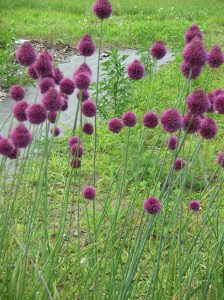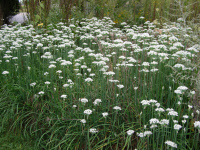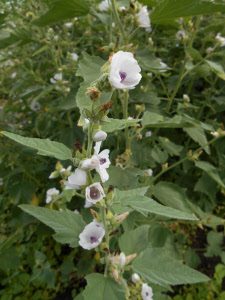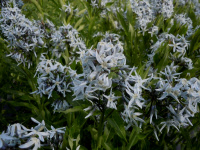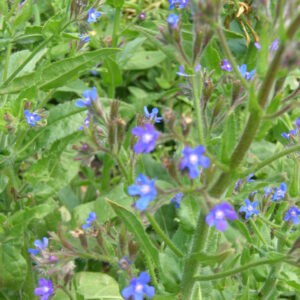Our Plants
Showing 25–32 of 587 results
-
Allium sphaerocephalon Drumstick allium Z 4-11
Claret colored, egg shaped flower heads
Claret colored, egg shaped flower heads top leafless stems in June to July. Good see-through plant to intermingle with purple coneflowers or tickseed. Good cut flower. Self-sows
We are very sorry, but due to state agricultural restrictions, we are not permitted to ship Allium bulbs to Idaho, or to the following five counties in the State of Washington: Adams, Benton, Franklin, Grant and Klickitat.
Size: 2-3’ x 2-3”
Care: sun in well-drained to moist well-drained soil.
Native: Mediterranean, Caucasus & Europe
Wildlife Value: attracts bees, butterflies and other insects.In gardens before 1750. Used as an edging around vegetables at Mount Vernon.
Allium sphaerocephalon is perhaps the most rugged, most enduring and most ubiquitous of all Alliums. It is indigenous to the lands of Great Britain, Europe, the Middle East, parts of Africa to as far west as the Caucasus mountains. It grows in the worst of soils and is tolerant of and appreciative of summer rains which distinguishes it from most other Alliums. It is also able to survive severe drought conditions. -
Allium tuberosum Garlic chives Z 4-8
August & September bright white balls the size of golf balls on erect stems. Ornamental in gardens and in arrangements, both fresh and dried, delicious edible.
August & September bright white balls the size of golf balls on erect stems. . Ornamental in gardens and in arrangements, both fresh and dried, delicious edible.
We are very sorry, but due to state agricultural restrictions, we are not permitted to ship Allium bulbs to Idaho, or to the following five counties in the State of Washington: Adams, Benton, Franklin, Grant and Klickitat.
Size: 12-18” x 8”
Care: Full sun or shade in any soil
Native: Southeast Asia
Wildlife Value: nectar source for many butterlies including the Tiger Swallowtail. Resists critters including deer, rabbits, squirrels, mice, and moles. They cannot stand the onion-like smell of Alliums protecting near-by plants too.Used medicinally in Asia as a remedy for incontinence, bladder weakness, kidney trouble and knee injuries. Traditional Chinese medicine practitioners made a powder from the seeds called Jiu Cai Zi used for numerous ailments.
-
Althaea officinalis Marshmallow Z 4-9
Small pale pink mallow-like blooms climb tall spires from July to September
Small pale pink mallow-like blooms climb tall spires from July to September
Size: 5-6’ x 3’
Care: Full sun moist to moist well-drained fertile soil. Heat and drought tolerant, stands up to wind with no staking needed.
Native: Central, south and east EuropeAlthaea is Greek meaning “to cure.” This was identified by Dioscorides in De Materica Medica for medicinal use around 70 A.D. More than 2000 years ago ancient Egyptians added honey to the cooked root. Ancient Romans used leaves and flowers as a strewing herb to repel lice and fleas. Emperor Charlemagne (742-814) cultivated the marshmallow in his gardens. According to Nicholas Culpepper, 16th century English herbalist, marshmallows were a medicinal candy. The plant eased pain, helped bloody fluxes, the stone and gravel and gripping of the belly. The marshmallow was considered to be an herb of Venus meaning that it voided offensive humors, made milk for nursing, cured bee stings, dandruff, balding and coughs. The French concocted the fluffy white confection in the mid 1800’s “from a decoction of marshmallow root, with gum to bind the ingredients together, beaten egg white to give lightness and to act as a drying agent, while sugar was incorporated to make the whole palatable.” American gardens since 1700’s when John Bartram received seeds from Europe. Jefferson grew it at Monticello. Grown at America’s 1st botanic garden, Elgin Botanic Garden 1811.
-
Amorpha canescens Lead plant Z 2-9
Arching violet spikes flower in mid-summer top pinnately compound, grey-green leaves.
OUT OF STOCK
Arching violet spikes flower in mid-summer atop pinnately compound, grey-green leaves. Liberty Hyde Bailey (1933): “Handsome free-flowering shrub of dense habit, well adapted for rockeries and borders …”
ONLY AVAILABLE TO SHIP IN EARLY SPRING, WHILE DORMANT. (USUALLY APRIL/MAY)
Size: 2-3’ x 2-3’
Care: sun in well-drained to moist well-drained soil
Native: Broad swath of central No. America from Canada to TX. Wisconsin native. Common shrub in Great Plains’ tall-grass prairies and seasonally wet soil.
Wildlife Value: Honeybees and butterflies; especially Whitney's Underwing, relish its nectar. Supports over 50 bee species.
Awards: Great Plants for Great PlainsAmorpha means “deformed” in Greek and “becoming grey” in Latin. Called Lead plant due to old belief that plant grew in soil containing lead. Used medicinally by numerous Native Americans to kill pinworms, remedy eczema, stomach aches, neuralgia, rheumatism, and cuts. Steeped leaves made tea for Oglala. Oglala mixed its dried leaves with buffalo fat for smoking. Winnebago powdered the leaves, added water, and applied it to skin to remedy scalds. They also ate the roots. Sioux: A tea made from leaves drank as a beverage, treated flu related congestion and as a bath for eczema. Dried leaves part of mixture for smoking. Pre-bison hunt ceremony used stems. 1st described in published work in 1813.
-
Amsonia hubrichtii Thread leaf amsonia, Arkansas amsonia Z 5-8
Powder-blue flowers in early summer; feathery foliage turns caution-sign yellow in fall.
Powder-blue flowers in early summer; feathery foliage turns caution-sign yellow in fall.
Size: 2-3’ x 2-3’
Care: sun to part shade in moist well-drained soil
Native: Central-So, US
Wildlife Value: attracts butterflies & bees
Awards: Missouri Botanic Garden Plant of Merit; Pennsylvania Horticultural Society Gold Medal; and Mount Cuba Center, botanic garden in Delaware, trialed several Amsonias and gave this its highest rating.Collected in 1940 in Yell County Arkansas along a stream 3 miles west of Birta.
-
Amsonia orientalis syn. Rhazya orientalis European bluestar Z 5-8
“Immensely tough and useful filler” “100 Plants Every Gardener Should Grow,” Gardens Illustrated No. 231 Purplish blue terminal flower clusters are larger and longer lasting than other Amsonia. Yellow foliage in Fall.
“Immensely tough and useful filler” “100 Plants Every Gardener Should Grow,” Gardens Illustrated No. 231
Purplish blue terminal flower clusters are larger and longer lasting than other Amsonia. Yellow foliage in Fall.Size: 12-20” x spreading
Care: sun to light shade in moist well-drained soil
Native: TurkeyDeer resistant, salt and heat tolerant. Classified as critically endangered as it is losing its native habitat and was over harvested. Collected before 1844.
-
Amsonia tabernaemontana Willow bluestar Z 4-10
Sky blue bells flower along terminal panicles from May to June. In fall thin, willow-like foliage turns sunny yellow.
Sky blue bells flower along terminal panicles from May to June. In fall thin, willow-like foliage turns sunny yellow.
Size: 24”x 18”
Care: sun to part shade in moist to moist-well-drained soil Heat and drought tolerant.
Native: Pennsylvania to Florida
Awards: Chicago Botanic Garden Award of Merit; Mount Cuba Center, botanic garden in Delaware, trialed several Amsonias and gave this its highest rating.Amsonia named for 18th century colonial Williamsburg physician Dr. John Amson, friend of American botanist, John Clayton (1694-1773) who forwarded the plant to English merchant and avid botanist Peter Collinson who then forwarded it to Linnaeus. Linnaeus awarded this its name in 1753. Tabernaemontana named for a physician, Jakob van Bergzabern who changed his name to Tabernaemontanus.
-
Anchusa azurea Bugloss Z 3-8
June-July true blue flowers, or all summer if deadheaded after bloom and before seeds set.
June-July true blue flowers, or all summer if deadheaded after bloom and before seeds set.
Size: 2-3' x 12'
Care: full sun in moist well-drained to well-drained soil.
Native: Mediterranean region“…perennial plant, with broad rough leaves … the branches grow more erect, and the flowers which are of a bright azure colour, are collected into spikes, coming out singly between the leaves.” Philip Miller 1768. ” Lovely rich gentian blue flowers, freely borne from May to August.” H.H. Thomas 1915. Recommended by Gertrude Jekyll, mother of today’s perennial gardens, in 1908. Anchusa from anchousa a paint used on skin.

